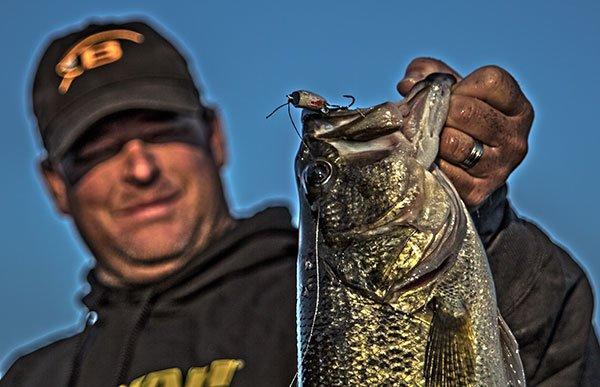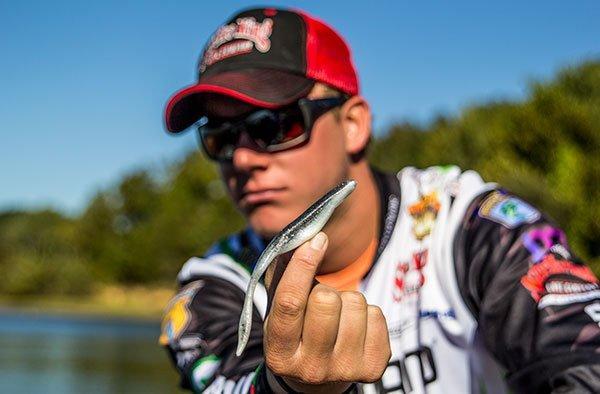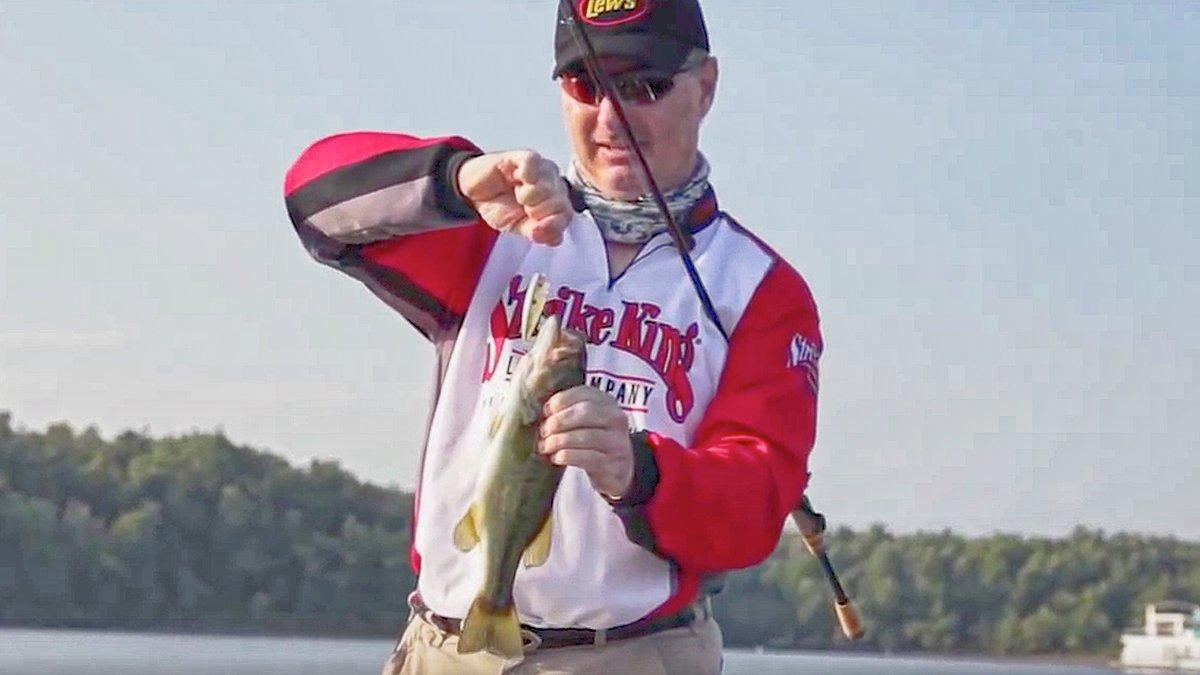Early prespawn bass fishing gives anglers an excellent opportunity to catch monster bass. As the bass emerge from their deep, wintertime haunts in preparation for the spawn, they are notoriously indiscriminate when it comes to their feeding behavior. The result is simple—giant bass and lots of them.
Elite Series pro Dean Rojas is one of the best at dissecting early prespawn patterns. As the days start getting longer, he primarily relies on five types of areas for his kicker fish.
Process of elimination
Although early prespawn bass can be quite predictable, it’s important to understand they’re like people in a sense—each one exhibits unique behavior. For this reason, Rojas is a staunch believer in the process of elimination throughout this time of year. Keeping the bass “honest†plays a big role in his strategy.
“Whenever you approach the beginning stages of the prespawn, I suggest going through a thorough process of elimination,†Rojas said. “While some folks like to start deep and work their way shallow, I’m actually the polar opposite. I always target the backs of creeks and short pockets before I do anything else.â€
The reason for Rojas’ plan is twofold. As one of the best shallow anglers in the world, he feels most confident fishing for bass in dirt-shallow water. More importantly, however, he believes shallow water plays host to more bass than you might think.
“It doesn’t matter where you go—there are always going to be bass in shallow water,†Rojas said. “Will they be the ones to win a tournament? That really depends on the fishery, but shallow areas give me a complete overview of the water temperature which is a huge deal in the early prespawn. It’s not uncommon to find places with nearby springs that will result in a five-degree water temperature increase. If you wait to go back there, you’ll never know and you might miss out on an incredible shallow bite.â€
Important factors to consider
Every bass angler is guilty of it. After months of ridiculously frigid water temperatures, we become glued to our electronics, searching for the warmest water possible. This obsessive behavior isn’t necessarily a bad thing, but make sure to keep an open mind towards other important factors as well.
“In my opinion, I think 50 degrees is the magic number for early prespawn movement,†Rojas said. “At that point, they’re ready to move and make something happen. But there’s something much more important than water temperature. Their clock heavily correlates with the length of days and it’s an easy thing to overlook. You can have a brutal cold front come in and they’ll still be steadily moving up if the days are getting longer.â€
If you’ve been around bass fishing for a while, there’s a great chance you’ve heard enough information about moon phase to make your head spin. Some folks give it a lot of credence while others, such as Rojas, don’t get too carried away with it.
“I don’t believe moon phase matters as much as people think,†Rojas said. “When I broke the weight record in Florida, we didn’t have a full moon—we actually had no moon. Regardless, we had the biggest influx of shallow bass I’ve ever seen. One warming trend is all it takes to turn it on fire.â€
Weather fronts matter
It never fails—just when you think you’re on a mega-bag of early prespawn bass, Mother Nature throws a wicked curveball and totally jacks up your plans. With a basic understanding of weather fronts and how they affect these early season fish, however, you’ll have a major advantage over the bass.
- Warming trends—“Warm weather can be a perfect storm for early prespawners,†Rojas said. “It gets them moving toward shallow water and turns them into ferocious feeders. If you like to save your bass fishing trips until the bite is red-hot, pick the third or fourth day of a warming trend to hit the water. Even if the water temperatures are still frigid, you’ll be amazed how shallow and aggressive they’ll be.â€
- Cold fronts—“Once early prespawn bass move shallow, they won’t go far—even in the event of a cold front,†Rojas said. “They’re not going to turn around and swim back to the river channels. Instead, they’ll tuck themselves deep into cover because they know what’s going on. In their minds, they know they just have to hang tight for a day or two until they can carry on with their business. It only days a few stable days for the fishing action to pick up where it left off.â€
Now that you have a basic understanding of the various factors that influence the behavior of early prespawn bass, you’re ready to start catching. According to Rojas, it’s hard to beat these five areas.
1. Funnels
A large part of fooling the year’s first wave of shallow bass revolves around locating congregation places, or funnels. These are areas such as bridge corners and riprap separating the main lake from backwater ponds. In order for the bass to migrate toward shallow water, they have no other choice than to swim through these areas.
“Funnels are outstanding ambush points for big bass,†Rojas said. “They don’t have to move very far to fatten up because the current—even if it’s just wind-generated—will push small forage right by their faces. Culverts and bridges are great places to focus on because they separate the bass from where they will eventually need to go. I caught a lot of great bass throughout the 2014 Classic doing this and that’s eventually how Randy Howell earned his victory.â€
- Bait considerations—“I like to start my dissection of funnels by paralleling the surrounding riprap or corners with hard reaction lures such as a SPRO Little John,†Rojas said. “After picking off the most aggressive fish, I’ll slow down and target any irregularities with a jig, a Big Bite Baits Trick Stick or sometimes even a Big Bite Baits Cane Thumper for the bigger, more sluggish bass.â€
- Things to remember—“It’s important to let these funnels rest for a few hours throughout the day,†Rojas said. “They will definitely replenish, so don’t beat it up too hard right off the bad. Lay off of it for a while when the action dies and make your way back to it later.â€
2. Primary points
Certain kinds of bass fishing structure can be very seasonal but that’s certainly not the case with primary points. These are shallow areas that jut into deeper main lake water and provide bass with two very important things—quick access to deep water and abundant feeding opportunities. This is why they’re so productive throughout the entire year.
“Bass use these points regardless of the conditions or time of year, so you can never go wrong with primary points,†Rojas said. “Points can be anything and they’re relative to each body of water. In a shallow fishery such as Okeechobee, they can be a one-foot drop while on deeper lakes such as Table Rock, they can be 30-foot drops. For early prespawners, they act as a natural stopping point throughout their shallow water migration. They come out of the river and creek channels and hang out on these points to feed.â€
- Bait considerations—“If the bass are actively feeding on top of the point, it’s hard to beat a shallow-running crankbait like the Little John,†Rojas said. “If you can’t get any bites with that, focus on the ends and sides of the point with a Fat Papa 70. If the action is slow, drag a 3/4-ounce football jig around and you should definitely get bit.â€
- Things to remember—“Not every primary point will be stacked with early prespawners,†Rojas said. “The bass can be very specific, so make an effort to hit as many points as you can and take notes about from where your bites are coming. This will help you piece together a solid pattern and dial-in on the most productive points.â€
3. Secondary points
As coldwater bass slowly make their way shallow in the earliest parts of spring, make sure to spend some time targeting secondary points, or smaller points within a creek. Remember, each fish is different—some just want to get the spawn done and over with while others take their sweet time. For those lackadaisical bass, secondary points are prime places to congregate.
“Secondary points are actually awesome areas for cold fronts in the early prespawn,†Rojas said. “That first wave of fish that tries to move shallow early in the year is very susceptible to cold fronts. When a front hits a lake, these bass will slide back to nearby secondary points and become absolutely stacked.â€
- Bait considerations—“Because I fish these areas a lot during a cold front, I’ll tend to use slower moving baits,†Rojas said. “The SPRO McRip 85 has been a big producer for me in recent years and when they want something slow, I’ll pull out a shaky head with a Big Bite Baits Trick Stick and really do some damage.â€
- Things to remember—“You can absolutely catch a bunch of fish on the shallow parts of secondary points, but don’t rule out the ditches on the sides and in front of them,†Rojas said. “They act as a natural highway and bass like to use the easiest way to get in and out of potential spawning areas.â€
4. Main lake flats
Fishing main lake flats this time of year can be really incredible or really bad—there’s not much in-between. Due to their potential, however, they’re always worth checking.
“Ideally, you want to concentrate on the ditches that lead into the flats,†Rojas said. “Make sure you focus your efforts on the first drop from the flat or in the ditches. These depressions are easy travel routes for bass and when a cold front hits like they tend to do this time of year, bass will slide back and hang out in these ditches until the weather passes. I spend a lot of time studying my Lowrance in order to find even the smallest depressions and irregularities.â€
- Bait considerations—“Whenever you’re fishing a big flat, it’s so important to break it down and cover as much water as possible,†Rojas said. “This makes reaction baits like a SPRO Aruku Shad an absolute necessity. You need something you can cast far and put in front of a lot of fish. If you find the fish ganged up in the ditches, try dragging a jig around or maybe a weightless Big Bite Baits Cane Stick.”
- Things to remember—“In order to dissect a flat thoroughly, pay close attention to your casts,†Rojas said. “I’ll usually cast in five-foot increments because I want to feel every stump, grass patch or ditch on the flat. It might take a while, but it’s totally worth it when you find the sweet spot.â€
5. Backwater ponds
The productivity of backwater ponds is well-documented, but rarely do you hear them come into conversation in just the first week of March. The lack of discussion actually makes them even better because if you find a solid group of fish in this type of area, you’re likely to have it all to yourself.
“If you can locate a backwater pond with stable water, there is no reason to leave,†Rojas said. “I know it’s weird to hear that so early in the year, but you have to think—you’ll always have fish coming to you. The shallow water warms up quickly, the days are getting longer and the bass are heading your way. They know where the warmer water is, so don’t rule these areas out in the early parts of the prespawn.â€
- Bait considerations—“These areas often act as their own little ecosystem, so you can kind of fish them like a farm pond, which is a ton of fun,†Rojas said. “If the fish are roaming around back there, you can pick them off with an Aruku Shad or Little John, but don’t rule out the shoreline cover, either. I’ll flip and pitch a Big Bite Baits Fighting Frog around isolated cover and catch some awesome bass.â€
- Things to remember—“Anytime you have a backwater pond, there will be a deeper ditch somewhere,†Rojas said. “Whether it’s a natural drain from fluctuating water levels or a ditch coming from a nearby funnel, bass love them. Much like fishing flats, spend a lot of time finding these ditches because they’ll lead you to the bass.â€
Sure—it might sound crazy to be discussing prespawn bass so early in the year, but small warming trends and stable water can make things happen overnight and it’s important to be prepared. If you can implement a process of elimination, understand what makes the bass migrate, adjust to weather fronts and target high percentage areas, you’ll be able to catch some monster prespawn bass before anyone else gets the memo.
















